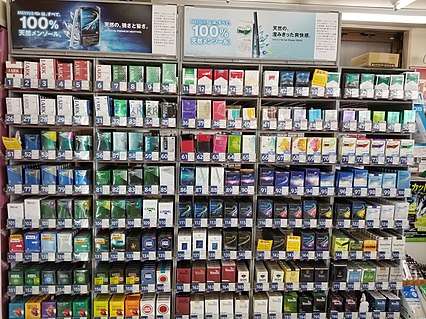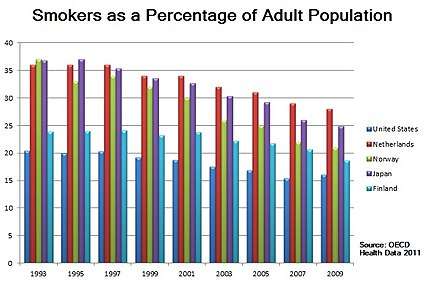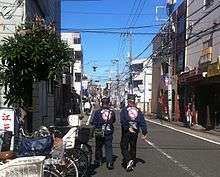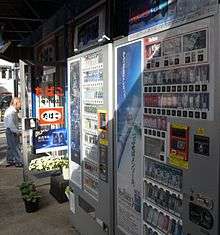Smoking in Japan
Smoking in Japan, though historically less restricted by law than in many other nations, has significantly changed in recent years. Tobacco use has been in nearly constant decline since 1996 and the decline has been mainly accelerating in recent years.[1] Per capita consumption in 2015 was 1,618 cigarettes, roughly 46% of the peak figure in 1977 and a number last seen in 1956.[2] In 2015, the adult smoking rate was 19.3%, 29.7% of Japanese men and 9.7% of Japanese women.[3] This is the lowest recorded figure since Japan Tobacco began surveying in 1965. As of July 2016, just over 20,000,000 people smoked in Japan, though the nation remained one of the world's largest tobacco markets.[4]

History

Until 1985, the tobacco industry was a government-run monopoly; the government of Japan is still involved in the industry through the Ministry of Finance, which after a sell-off in March 2013, now owns only one third of Japan Tobacco's outstanding stock, and the Ministry of Health, Labour, and Welfare, which is active in public health and other tobacco control policy making.[5]
The Diet of Japan has many MPs who have interests in the tobacco industry and thus tobacco control legislation is uncommon.[6]
Non-smoking areas are becoming increasingly common in Japan, in homes, offices, restaurants, fast-food eateries, "family restaurants," pachinko parlors, and public areas.[7] Kanagawa Prefecture enacted Japan's first smoke-free public places ordinance in 2009 and Hyogo Prefecture followed with a similar law in 2012.[8] All trains either have non-smoking cars or are completely smoking-free, as are many train station platforms in urban areas.[9]
Pricing
A particular brand of cigarettes in Japan costs the same across all vendors, from cigarette machines to big supermarkets to corner shops. Bulk purchases are not discounted. As of 6 August 2013, the price of a typical pack of cigarettes ranged from ¥410 to ¥440 yen. Because of the hike in the consumption sales tax to 8% on 1 April 2014, the range is now 430 to 460 yen.
Smoking bans

Unlike in Europe, Australia and North America, where mandatory smoking bans apply in restaurants, bars, and public areas, smoking in Japan is not made illegal by Article 25 of the nation's Health Promotion Act, which merely urges smoking restrictions. Limited indoor bans have been enacted in Kanagawa and Hyogo Prefectures, but not nationally. Other restrictions may be implemented by the choice of public and private property owners, managers, employers, etc.[10]
Many of the wealthier wards of Tokyo, such as Shinjuku and Shibuya, are applying various kinds of anti-smoking laws. They have designated special smoking sections in areas and it is punishable by fine if caught smoking outside these areas. Chiyoda-ku banned smoking while walking on busy streets from November 2002, the first local government in Japan to do so.[11]
Starting in 2007, Kyoto began designating certain city streets as non-smoking areas, and have since then been increasing the number of streets designated as such.[12][13] In a 2010 report, Kyoto Prefecture stated that the major goal of their anti-smoking policies is "to ensure that there is zero chance for people to suffer from second-hand smoke in Kyoto prefecture."[14]
Corporate policy
Starbucks is one of the few service industry companies in Japan that bans smoking inside all of its stores,[15] but allows smoking and provides ashtrays in the outside seating areas at most stores in Osaka. McDonald's Japan plans to ban smoking at some of its stores following renovations,[15] and has banned smoking at its 298 restaurants in Kanagawa prefecture since 1 March 2010.[16] Kentucky Fried Chicken banned smoking at one branch in Shibuya, Tokyo in July 2010.[15]
Japanese women and smoking
_-_Korinsai.jpg)
Woodblock print believed to be by Korinsai, dating between 1785 and 1790. She is smoking with a long kiseru.
Woodcut print by Torii Kiyonaga, around 1784. A long kiseru beside one of three prostitutes (yūjo) who is reading a paper in a brothel at Shinagawa, Tokyo.
While a high percentage of men in Japan have smoked throughout in the postwar years, the rate for women for many years hovered between 10 and 15%, followed there too by a decline in recent years to be floating currently a little below 10%.[18]
In the mid-1990s, the number of younger female smokers in particular had risen substantially. Smoking has since declined among this group as well, but that cohort of women still smokes at a higher rate than their elders.[18] "The manufacturers were very successful in providing cool images to the consumers," says Ministry of Health and Welfare technical officer Yumiko Mochizuki, when asked to explain the steady rise in female smokers. "Until recently, the Ministry of Health and Welfare had an understanding that smoking was entirely up to the individual."[19]
The government's advertising ban based on the "motherhood" argument was watertight until the tobacco industry was privatized in 1985. Advertising that encourages women to smoke is forbidden in Japan under a voluntary industry agreement. The industry group pledged to voluntarily honor the advertising ban and is charged with enforcing it. United States maker Brown & Williamson sells Capri cigarettes in Japan in slim white boxes with a flower-like design on the cover. R.J. Reynolds' Tokyo billboards for Salem's Pianissimo cigarettes are green-and-pink. Philip Morris advertised its Virginia Slims brand with the slogan "Be You" in an ad campaign.
Other factors contribute to the rise in female smokers. Some observers cite stress, saying that more Japanese women are smoking to relax as more enter the workforce. Others argue that smoking is one arena in which women can have equality with men. Media influence is also cited, as many women on popular Japanese television dramas smoke.
Cigarette vending machines

Cigarettes can be bought in tobacco stores and at vending machines, and public ashtrays dot sidewalks and train platforms. The number of cigarette vending machines in Japan is estimated at 500,000 in 2002.[20]
The law prohibits the smoking of cigarettes by persons under the age of twenty.[21]
Taspo is a smart card developed by the Tobacco Institute of Japan, the nationwide association of tobacco retailers, and the Japan Vending Machine Manufacturers Association. Introduced in 2008, the card is necessary to purchase cigarettes from vending machines.
In 2008 Japan Tobacco commissioned a series of over 70 public service announcement style "smoking manner" posters about smoking etiquette.[22][23] The ads were displayed in a wide variety of formats ranging from placards in the subway to postcards to beverage coasters.
See also
References
- Levin, Mark, Tobacco Control Lessons from the Higgs Boson: Observing a Hidden Field Behind Changing Tobacco Norms in Japan. American Journal of Law and Medicine, 39 (2013): 471-489. Available at SSRN: http://ssrn.com/abstract=2230999
- Levin, Mark, Puffing Precedents: The Impact of the WHO FCTC on Tobacco Product Liability Litigation in Japan. Asian Journal of WTO & International Health Law and Policy, vol. 11, no. 1, 2016 at p. 23. Available at SSRN: https://papers.ssrn.com/sol3/Papers.cfm?abstract_id=2741874
- Japan Times
- cigarette use globally
- Levin, Tobacco Control Lessons (2013) at 474, 480-481.
- Birtley, Tony (January 18, 2007). "Long road for anti-smoking Japanese". Al Jazeera. Retrieved 2008-10-28.
- Levin, Tobacco Control Lessons (2013) at 485.
- Id. at 481-482.
- JR East: Concerning the separation of smoking and non-smoking areas (in Japanese)
- "Tobacco Control Laws, Country Details for Japan". Campaign for Tobacco Free Kids. Retrieved 2013-08-05.
- "Smoking ban on Tokyo's streets". BBC News. 2 October 2002. Retrieved 4 September 2010.
- 7月1日施行 (in Japanese). Kyoto Shimbun. 2010-04-23. Retrieved 2012-05-16.
- 路上喫煙禁止を拡大 (in Japanese). Kyoto Shimbun. 2012-02-01. Retrieved 2012-05-16.
- "京都府における受動喫煙防止対策の目標". 京都府における受動喫煙防止対策に関する報告書 (in Japanese). Kyoto Prefecture. Retrieved 2012-05-16.
quote: 【大 目 標】 京都府内で人が受動喫煙を受ける機会をゼロにする
- "Most new McDonalds' outlets to ban smoking". Asahi Shimbun. 2010-08-09. Retrieved 4 September 2010.
- Koh, Yoree (August 10, 2010). "McDonald's to Snuff Out Smoking in Japan?". Wall Street Journal. Retrieved 4 September 2010.
- NAGASHIMA, Atsuko (2007-06-30). "『農業図絵』にみる喫煙とジェンダー" (PDF). Research Paper; 非文字資料研究 News Letter, 16: 23-23 (in Japanese). Kanagawa University Repository. Retrieved 2012-05-16.
- http://www.health-net.or.jp/tobacco/product/pd090000.html and http://www.health-net.or.jp/tobacco/product/pd090000.html
- "Japan Ads Sell Women On Smoking | csmonitor.com". Csmonitor.com. Archived from the original on November 2, 2008. Retrieved 2008-11-04.
- "Smoking Statistics: 28 May 2002". 2005-2011 World Health Organization, Regional Office for the Western Pacific. 2002-05-28. Archived from the original on July 7, 2011. Retrieved 2012-05-16.
With 500,000 cigarette vending machines, the young can easily buy cigarettes.
- "Smoking in Japan". Japan-guide.com. Retrieved 2008-11-04.
- Japan Tobacco's Delightfully Disturbing 'Smoking Manners for Adults' Ads Steve Levenstein
- Japan Tobacco's Clever and Strange Smoking Manners Signs Common Craft, February 23, 2008
External links
- 「マナーの気づき1」篇 グラフィック広告(イラスト一覧) Japan Tobacco (in Japanese)
- Ozasa, Shunichi (February 18, 2010). "Japan to Seek Total Smoking Ban in Public Places, Yomiuri Says". Bloomberg.
